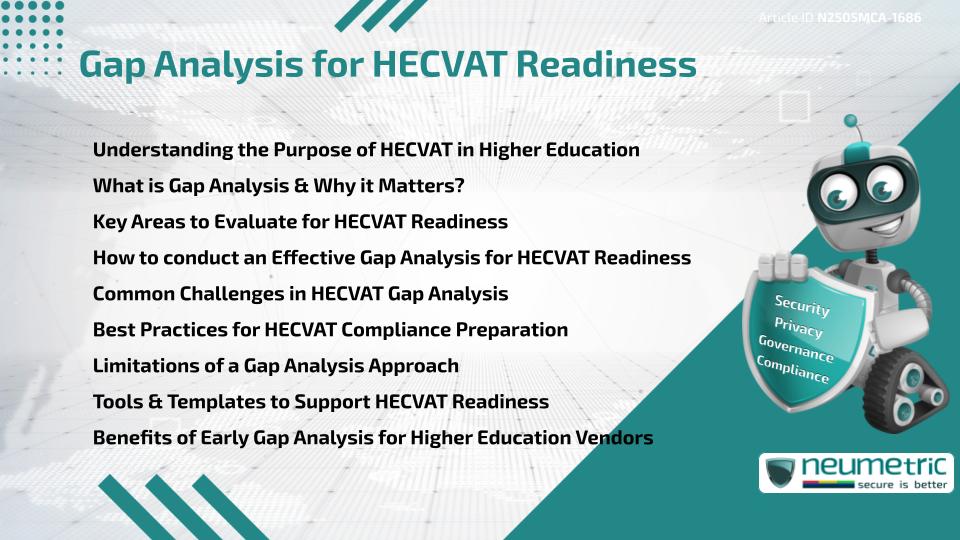Table of Contents
ToggleIntroduction
Colleges & universities are increasingly dependent on Third Party software vendors to manage data, support operations & improve services. To ensure these vendors uphold strong security practices, many institutions rely on the Higher Education Community Vendor Assessment Toolkit [HECVAT]. A critical step in preparing for this assessment is performing a Gap Analysis for HECVAT readiness. This article explains what that entails, why it matters & how it can help vendors align with higher education security expectations.
Understanding the Purpose of HECVAT in Higher Education
The HECVAT was developed by EDUCAUSE to help colleges & universities evaluate vendor Risk in a consistent & scalable way. It addresses common concerns around Data Security, Privacy & cloud usage.
HECVAT is not just a checklist. It represents a set of expectations that vendors must meet to demonstrate they are trustworthy partners. Completing the HECVAT ensures that vendors are transparent about their practices & have necessary safeguards in place.
What is Gap Analysis & Why it Matters?
A Gap Analysis is a strategic comparison between current capabilities & required standards. In the context of HECVAT, it helps vendors identify where their security & Compliance processes fall short.
Performing a Gap Analysis for HECVAT readiness provides several benefits:
- It reduces the Risk of rejection by higher education clients.
- It prepares internal teams for required changes.
- It highlights areas that require new Policies or technology improvements.
Without this step, vendors may approach the HECVAT blind, resulting in delays or security blind spots.
Key Areas to Evaluate for HECVAT Readiness
There are several focus areas a vendor should assess:
- Data Governance: Are there documented data handling practices in place?
- Access Controls: Is User access monitored & restricted appropriately?
- Incident Response: Is there a formal plan for managing breaches?
- Cloud Security: Are cloud environments properly configured & monitored?
- Compliance Mapping: Do current practices align with FERPA & other education-specific regulations?
A solid Gap Analysis for HECVAT readiness looks at these areas holistically rather than in isolation.
How to conduct an Effective Gap Analysis for HECVAT Readiness
Here is a step-by-step breakdown:
- Download the Right HECVAT Version: Use the HECVAT Lite for smaller engagements or the full version for complex environments.
- Assign Ownership: Identify a lead analyst or security officer to manage the assessment.
- Self-Assessment: Review each HECVAT question honestly against current documentation & controls.
- Score & prioritise Gaps: Categorize gaps by severity—low, medium & high Risk.
- Create a Remediation Roadmap: Develop action items with deadlines & responsible teams.
This structured approach makes the Gap Analysis for HECVAT readiness actionable & measurable.
Common Challenges in HECVAT Gap Analysis
Despite good intentions, Organisations often struggle with:
- Incomplete documentation: Many vendors lack formalized processes, making it hard to answer HECVAT questions.
- Limited team involvement: Assessments conducted by a single person may overlook operational realities.
- Unclear terminology: Even well-meaning teams can misinterpret security terms, leading to false positives or omissions.
Overcoming these issues requires cross-functional collaboration & an understanding of HECVAT’s educational context.
Best Practices for HECVAT Compliance Preparation
To ensure success, vendors should:
- Start the Gap Analysis for HECVAT readiness early in the engagement process.
- Create a shared folder for Policies, procedures & completed responses.
- Use security awareness tools to train internal teams on data responsibility.
- Regularly review & update responses to reflect system changes.
These habits create a foundation of transparency that higher education clients value.
Limitations of a Gap Analysis Approach
Although beneficial, a Gap Analysis for HECVAT readiness is not foolproof. It may:
- Miss emerging Threats that are not reflected in the current HECVAT version.
- Give a false sense of readiness if responses are overly optimistic.
- Rely heavily on documentation rather than real-world testing.
To address these, vendors can complement the analysis with a Penetration Test or External Audit.
Tools & Templates to Support HECVAT Readiness
Several resources simplify the process:
- HECVAT Questionnaire Templates
- Policy automation tools like Drata or Vanta
- Risk register spreadsheets to log & track identified issues
Using these tools allows for a more accurate & efficient Gap Analysis for HECVAT readiness.
Benefits of Early Gap Analysis for Higher Education Vendors
Conducting the Gap Analysis for HECVAT readiness early gives vendors a head start in negotiations & ensures fewer surprises. It builds credibility & shows higher education institutions that the vendor understands the unique requirements of their environment. This trust can accelerate deal cycles & long-term partnerships.
Takeaways
- The Gap Analysis for HECVAT readiness bridges the gap between vendor practices & academic expectations.
- It allows vendors to proactively identify & address security weaknesses.
- Tools, planning & Stakeholder involvement are key to its success.
- While helpful, a Gap Analysis should be one part of a broader security & Compliance effort.
FAQ
What is the purpose of a Gap Analysis for HECVAT readiness?
It helps vendors compare their current practices to HECVAT standards & identify areas where improvements are needed.
When should vendors start the Gap Analysis for HECVAT readiness?
Ideally, before responding to any university RFPs or before the sales engagement begins.
Who should conduct the Gap Analysis for HECVAT readiness?
A cross-functional team including security, Compliance & product management professionals.
What are the top tools for Gap Analysis for HECVAT readiness?
HECVAT templates, policy documentation platforms & Risk tracking spreadsheets are the most helpful.
Is Gap Analysis for HECVAT readiness mandatory?
It is not mandatory but strongly recommended to avoid delays or security concerns during Client evaluations.
How long does Gap Analysis for HECVAT readiness take?
Depending on complexity, it can take anywhere from one (1) week to four (4) weeks.
Can Gap Analysis for HECVAT readiness be outsourced?
Yes, Third Party consultants with higher education experience can assist with the process.
Does Gap Analysis for HECVAT readiness apply to small vendors?
Yes, even small vendors are expected to meet minimum security expectations defined by HECVAT.
What happens after Gap Analysis for HECVAT readiness?
Vendors should address gaps, document changes & prepare to submit a completed HECVAT response to the institution.
Need help?
Neumetric provides organisations the necessary help to achieve their Cybersecurity, Compliance, Governance, Privacy, Certifications & Pentesting goals.
Organisations & Businesses, specifically those which provide SaaS & AI Solutions, usually need a Cybersecurity Partner for meeting & maintaining the ongoing Security & Privacy needs & requirements of their Clients & Customers.
SOC 2, ISO 27001, ISO 42001, NIST, HIPAA, HECVAT, EU GDPR are some of the Frameworks that are served by Fusion – a centralised, automated, AI-enabled SaaS Solution created & managed by Neumetric.
Reach out to us!





